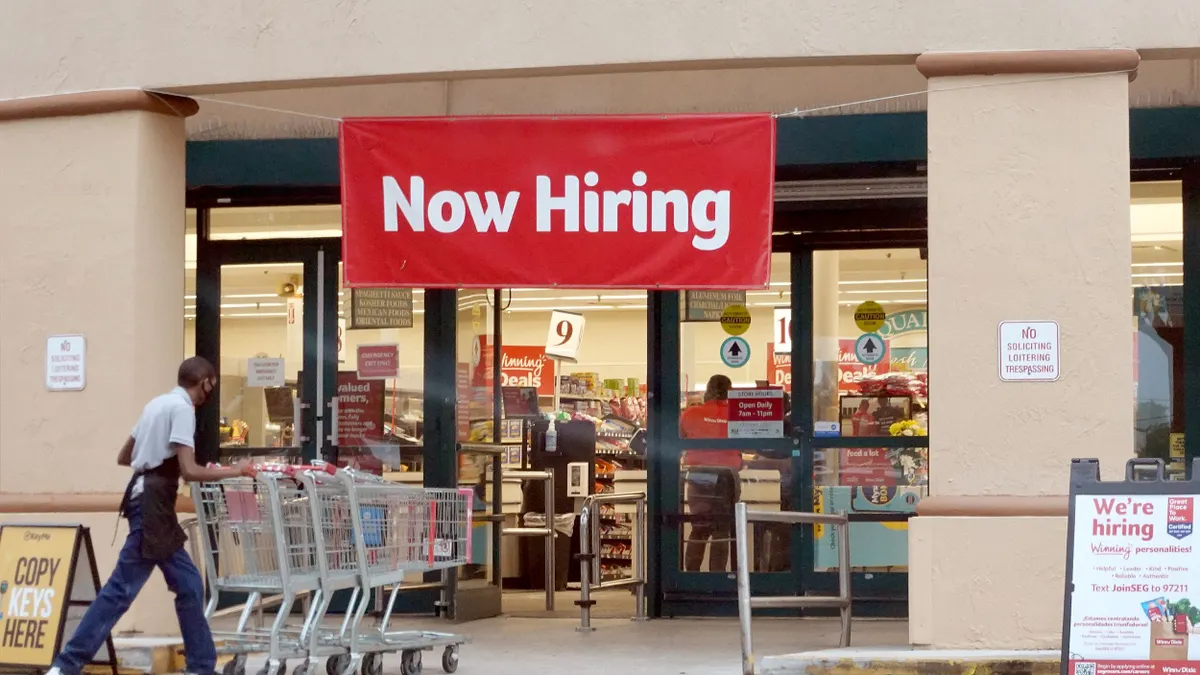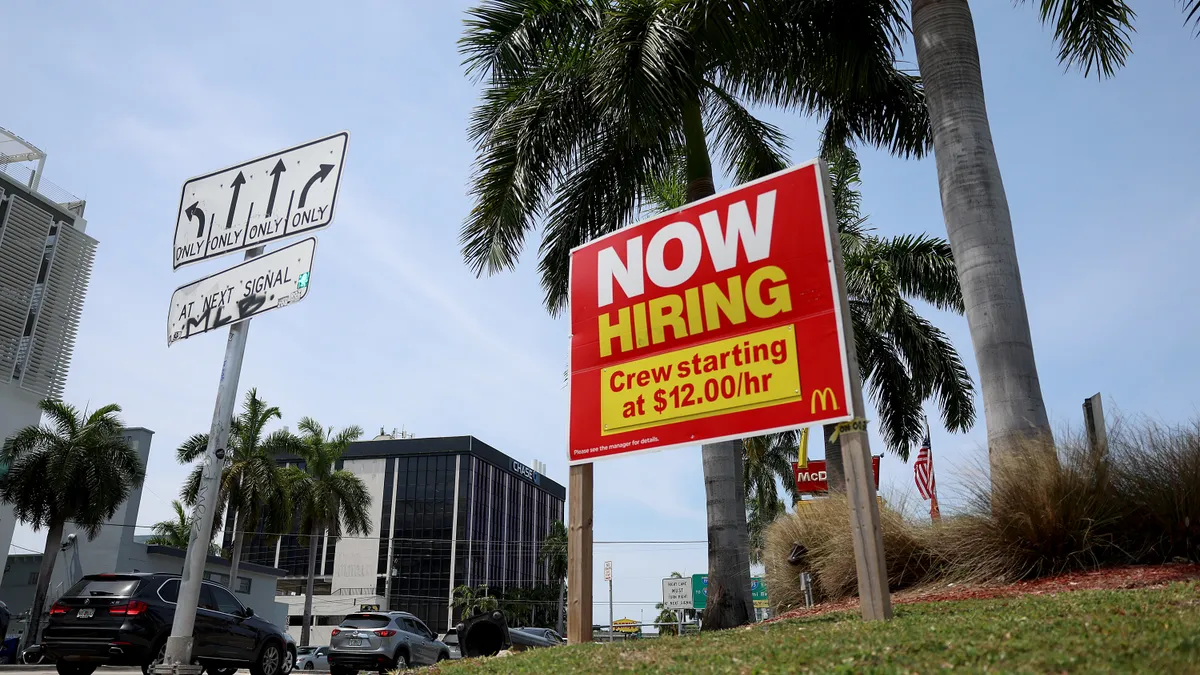Last May, Maine’s governor Paul LePage announced a unique solution for filling hospitality industry jobs in the state’s tight labor market: hiring recently released prisoners. The plan to provide conditional commutations on sentences of a small group of non-violent criminals to bring them into the workforce highlights the problem businesses are facing across the country and across industries. There are simply not enough workers.
“According to the Bureau of Labor Statistics, employment is increasing by an average of 170,000 jobs per month,” Jim Link, chief human resources officer, Randstad North America, told HR Dive in an email. “As Baby Boomers retire, they’re leaving open positions behind requiring expertise, and as many industries continue to adopt technology, new jobs are being created faster than employees can fill them,” he added.
While businesses may be aware of the skills gap in emerging technology, the lack of eligible employees is also being felt in other industries, like Maine’s hospitality industry, as well as healthcare, manufacturing and construction.
And although technology is becoming integral for every type of business, some jobs just can’t be automated, and those may suffer, says Gad Levanon, chief economist, North America for the Conference Board, a global, independent business-membership and research association. Cleaning staff in a hotel, for example, cannot be replaced by robots, he says.
As baby boomers retire, significant employee shortages will be found in jobs that don’t require a bachelor’s degree but do require some skills and on the job training, such as machinists, electricians, plant operators and rail transportation workers. “They’re not the cool and sexy occupations the younger generation wants to get into,” Levanon says.
But, unfortunately, it's likely the skills gap will get worse before it gets better. The lack of growth in the working age population coupled with the massive exodus of baby boomers over the next 12 years will spell trouble for businesses for at least the next decade, Levanon predicts. To survive, organizations must explore new ways to attract and retain employees. Below, we outline some practices employers and public institutions are taking to try and solve the skills gap.
Recruiting tactics
Widen the pool of applicants. Actively recruit traditionally overlooked demographics, Levanon suggests. This can include veterans, women who might return to work after taking a career break, the formerly incarcerated, people with disabilities, older workers, gig employees, immigrants and discouraged workers. This tactic will require an employer look beyond their usual recruiting zones, but could go a long way in improving diversity and, therefore, the bottom line.
Go where the employees are. Not every area has the same type of labor shortage, Levanon says. After the Great Recession, Michigan had a glut of highly skilled workers from the auto industry and other manufacturing jobs. Companies are moving operations to Michigan to take advantage of a high quality labor market, he says.
During the recruiting and interviewing process, focus on the true job needs. Make sure the skills required are must-haves, not just nice-to-haves, says Seth Robinson, senior director of technology analysis at CompTIA, an IT industry association.
“In the software development space, it’s very common to have a whiteboard interview — a candidate comes in and an engineer says, ‘here’s a problem, can you code [the solution] on a whiteboard?’” Robinson said. This measures a candidate’s coding skill and ability for quick thinking. However, in the job, an employee is more likely to develop code while sitting at a desk, in a group, with more time to think, meaning a white board interview could weed out a perfectly skilled candidate due to an unrealistic job expectation.
Consider development
Hire for cultural fit; develop employees' skills post-hire. “Companies are realizing there’s more to being a good worker than simply knowing how to do a job or having a particular skill set,” says Link. “We will see more and more employers place an emphasis on training existing or future hires, especially when they find the culture fit they are looking for, or a candidate with superb soft skills.”
Employers should be careful when hiring explicitly for cultural fit to not accidentally discriminate against certain individuals. But generally, employers should focus on hiring people who fit the company's values and work ethic. Most tech skills can be taught; most people skills can't.
Provide employer-funded upskilling or reskilling to meet STEM talent needs. Link says companies will invest in more training of employees. According to Randstad’s Workmonitor Q3 report, 67% of employees say they need more training to stay current or prepare for future needs, but their employees aren’t providing or paying for it. Forward-thinking employers have a clear opportunity to step in to both future-proof their organization and better retain employees.
At the same time, the process of job transitioning is more than a split decision. Forming a training program requires intensive planning and a myriad of choices, among them: Should workers be aiming for jobs that will keep them at relatively stable (or perhaps increased) wage prospects compared to their current job, or should wage be absent from that consideration?
There are huge implications hinging on that decision, a World Economic Forum (WFE) analysis of data from the U.S. Bureau of Labor Statistics and Burning Glass Technologies (see table below) shows.
| Outcomes | With stable wage requirement | With no wage restrictions |
|---|---|---|
| Job transitions with ‘good-fit’ options (millions/share of workers) | 1.369 (95.3%) | 1.383 (96.3%) |
| Job transitions without ‘good-fit’ options (millions/share of workers) | 0.067 (4.7%) | 0.053 (3.7%) |
| Share of job transitions that involve a change in job family | 70% | 71% |
| Share of job transitions with stable or increasing wages | 100% | 65% |
| For those increasing, average annual wage increase | $15,200 | $19,000 |
| Share of job transitions with reduction in wages | n/a | 35% |
| For those decreasing, average annual wage decrease | n/a | $8,600 |
| Average additional years of work experience required | 2.0 | 1.7 |
| Average additional years of work education required | 2.0 | 1.0 |
On the whole, a job transition model that does not require stable wages would steer a larger proportion (+1%) of workers toward a "good-fit" job — i.e. a job for which the candidate has the appropriate skills, knowledge and experience to perform — compared to a model that prioritizes stable wages. Over a third (35%) of workers, however, would have to accept a pay cut under this model.
A stable wage requirement, on the other hand, eliminates pay cuts due to job transitions, but also delivers fewer "good-fit" outcomes, a lower average wage increase and increases the average prerequisite additional years of work experience and work education.
The point is not merely to illustrate that one approach to wages is better than the other; employers must acknowledge the role of compensation in the re-skilling process and adjust their programs based on what works best for workers in their particular industries.
Look beyond traditional methods to train employees. “In 2018, we expect employers will look beyond traditional training methods, like workshops, and will think outside of the box to implement newer methods, like online learning, MOOCs and gamification platforms, to deliver training on new skills or to strengthen existing skills [for] employees in more engaging ways,” says Link.
Don't forget wages and benefits
To attract and retain employees, companies will have to pay competitive wages. Even now, some municipalities, cities and states are paying higher than the minimum wage to keep employees. But even as revenue increases, the increased wages will cut into profits, which can be detrimental, particularly to smaller businesses, Levanon says.
But even industries known for their lower wages are beginning to see the writing on the wall. Big name retailers have begun to improve their wages and benefits offerings to differentiate themselves in the market.
The skills gap will continue for the foreseeable future and employers face a daunting challenge. To succeed, the workplace of the future must be more open to candidates of nontraditional backgrounds, provide more on-the-job training, create environments where employees want to stay and find a way to offer the wages and benefits needed to retain employees, while remaining profitable.




















